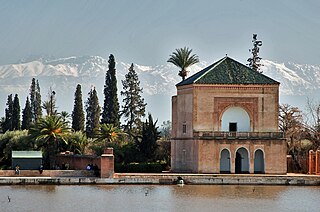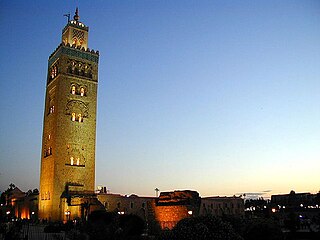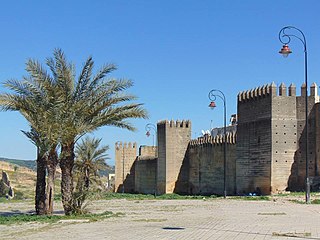
Marrakesh or Marrakech is the fourth-largest city in Morocco. It is one of the four imperial cities of Morocco and is the capital of the Marrakesh–Safi region. The city lies west of the foothills of the Atlas Mountains.

A riad or riyad is a type of garden courtyard historically associated with house and palace architecture in the Maghreb and al-Andalus. Its classic form is a rectangular garden divided into four quadrants by two paved paths intersecting in the center, where a fountain is typically situated. The planted areas are usually sunken below the level of the paths. Its origin is generally attributed to traditional Persian gardens whose influence spread during the Islamic period. The term "riad" is nowadays often used in Morocco to refer to a hotel or guesthouse-style accommodation with shared common areas and private rooms, often within a restored traditional mansion.

El Badi Palace or Badi' Palace is a ruined palace located in Marrakesh, Morocco. It was commissioned by the sultan Ahmad al-Mansur of the Saadian dynasty a few months after his accession in 1578, with construction and embellishment continuing throughout most of his reign. The palace, decorated with materials imported from numerous countries ranging from Italy to Mali, was used for receptions and designed to showcase the Sultan's wealth and power. It was one part of a larger Saadian palace complex occupying the Kasbah district of Marrakesh.

The Saadian Tombs are a historic royal necropolis in Marrakesh, Morocco, located on the south side of the Kasbah Mosque, inside the royal kasbah (citadel) district of the city. They date to the time of the Saadian dynasty and in particular to the reign of Ahmad al-Mansur (1578–1603), though members of Morocco's monarchy continued to be buried here for a time afterwards. The complex is regarded by many art historians as the high point of Moroccan architecture in the Saadian period due to its luxurious decoration and careful interior design. Today the site is a major tourist attraction in Marrakesh.

Fes Jdid or Fes el-Jdid is one of the three parts of Fez, the second largest city of Morocco. It was founded by the Marinids in 1276 as an extension of Fes el Bali and as a royal citadel and capital. It is occupied in large part by the historic Royal Palace, which was once the center of government in Morocco and which is still used on occasion by the King of Morocco today. The district also contains the historic Mellah of the city. Since 1981 it has been classified, along with Fes el-Bali, as a UNESCO World Heritage Site.

The Menara Gardens are a historic public garden and orchard in Marrakech, Morocco. They were established in the 12th century by the Almohad Caliphate ruler Abd al-Mu'min. Along with the Agdal Gardens and the historic walled city of Marrakesh, the gardens have been listed as UNESCO World Heritage Site since 1985. The gardens are laid out around a central water basin and reservoir, next to which is a pleasure pavilion dating in its current form from the 19th century. The reservoir and its pavilion, often framed in pictures against the background of the High Atlas Mountains to the south, are considered one of the iconic views and symbols of Marrakesh.

Mechouar or meshwar is a type of location, typically a courtyard within a palace or a public square at the entrance of a palace, in the Maghreb or in historic al-Andalus. It can serve various functions such as a place of assembly or consultation, an administrative area where the government's affairs are managed. It was the place where the sultan historically held audiences, receptions and ceremonies. The name is sometimes also given to a larger area encompassing the palace, such as the citadel or royal district of a city.

Bab Agnaou, also transliterated as Bab Agnaw, is one of the best-known gates of Marrakesh, Morocco. Its construction is attributed to the Almohad caliph Abu Yusuf Ya'qub al-Mansur and was completed around 1188 or 1190.

This article describes notable landmarks, architecture, and museums in the city of Marrakesh, Morocco.

The Agdal Gardens are a large area of historic gardens and orchards in Marrakesh, Morocco. The gardens are located to the south of the city's historic Kasbah and its royal palace. Together with the medina of Marrakech and the Menara Gardens, the Agdal Gardens were listed by UNESCO as a World Heritage Site in 1985. The gardens contain several historic water reservoirs as well as several historic palaces and pavilions, including the Dar el-Hana and the Dar al-Bayda.

Bab Ksiba is a gate in Marrakech, Morocco. Bab Ksiba and another more famous gate further north, Bab Agnaou, served as entrances to the royal Kasbah (citadel) in the southern part of the medina of Marrakech, a UNESCO World Heritage Site.

Almohad architecture corresponds to a period from the 12th to early 13th centuries when the Almohads ruled over the western Maghreb and al-Andalus. It was an important phase in the consolidation of a regional Moorish architecture shared across these territories, continuing some of the trends of the preceding Almoravid period and of Almoravid architecture.

The history of Marrakesh, a city in southern Morocco, stretches back nearly a thousand years. The country of Morocco itself is named after it.

The Kasbah Mosque, also known as the Moulay al-Yazid Mosque, is a historic mosque in Marrakesh, Morocco. It was originally built by the Almohad ruler Yaqub al-Mansur in 1185–1190 CE. It is located in the Kasbah district, the city's former citadel, near the site of its historic royal palaces. Along with the Kutubiyya Mosque, it is one of the most important historic mosques in Marrakesh.

The Royal Palace or Dar al-Makhzen is the palace of the King of Morocco in the city of Fez, Morocco. Its original foundation dates back to the foundation of Fes el-Jdid, the royal citadel of the Marinid dynasty, in 1276 CE. Most of the palace today dates from the 'Alawi era. The vast grounds are home to multiple private structures, patios, and gardens, but historically also included administrative offices and government tribunals. Today, the most publicly visible parts of the palace are its main entrances at the Old Mechouar and the highly ornate 20th-century gates at Place des Alaouites, near the Mellah.

The Fortifications of Fez comprise a complex circuit of ramparts and gates surrounding Fes el-Bali and Fes el-Jdid, two urban agglomerations that compose the old "medina" of Fes, Morocco. They also include a number of kasbahs (citadels) and forts which were built both to protect and to control the city. These fortifications have been built up over many centuries and the extensive remnants today date from many different periods.

The architecture of Fez, Morocco, reflects the wider trends of Moroccan architecture dating from the city's foundation in the late 8th century and up to modern times. The old city (medina) of Fes, consisting of Fes el-Bali and Fes el-Jdid, is notable for being an exceptionally well-preserved medieval North African city and is classified as a UNESCO World Heritage Site. A large number of historic monuments from different periods still exist in it today, including mosques, madrasas, synagogues, hammams (bathhouses), souqs (markets), funduqs (caravanserais), defensive walls, city gates, historic houses, and palaces.
The Barrima Mosque is a mosque in Marrakesh, Morocco, attached to the Kasbah (citadel) and Royal Palace of the city. It was built in the late 18th century by the Alaouite sultan Muhammad ibn Abdallah.

The Walls of Marrakesh are a set of defensive ramparts which enclose the historic medina districts of Marrakesh, Morocco. They were first laid out in the early 12th century by the Almoravid dynasty which founded the city in 1070 CE as their new capital. The walls have since been expanded several times by the addition of the Kasbah to the south at the end of the 12th century and by a later extension to encompass the northern neighbourhood around the Zawiya of Sidi Bel Abbes.

The Kasbah of Moulay Ismail is a vast palace complex and royal kasbah (citadel) built by the Moroccan sultan Moulay Isma'il ibn Sharif in Meknes, Morocco. It is also known, among other names, as the Imperial City or Palaceof Moulay Ismail, or the Kasbah of Meknes. It was built by Moulay Isma'il over the many decades of his reign between 1672 and 1727, when he made Meknes the capital of Morocco, and received occasional additions under later sultans.


































